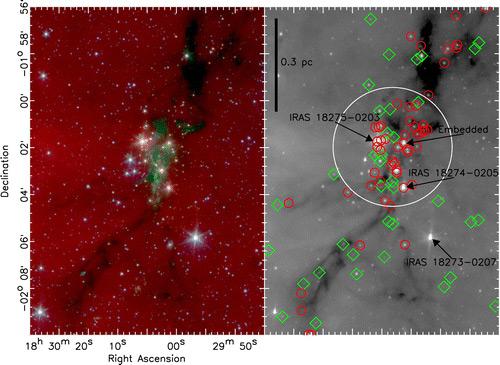
(Left) A false-color infrared image of the young stellar cluster in Serpens. The astronomical coordinates label the axes. (Right) The labels identify the locations of the dense cluster core (white circle), the very young stellar embryos (red circles), and slightly older stars that have protoplanetary disks (green diamonds); also provided are some object names and a marker showing one light-year (labeled "0.3pc" - for comparison, the nearest star to the sun is 4 light-years away.)
On average, one new star a year is born in a nursery somewhere in our Milky Way galaxy, at least according to the best current approximations. Stellar nurseries are located in giant clouds of molecular gas and dust found throughout the galaxy, especially in its spiral arms, and each of these fertile regions is eventually expected to produce multiple stars. Sometimes the newborns arrive together, in a dense cluster, but there are few studies of very young clusters or their properties. The sun, for example, might have formed in a cluster that later dissipated; a better understanding of such groups would help scientists understand the environment in which the young solar system evolved.
A team of fifteen scientists led by SAO astronomers Rob Gutermuth, Tyler Bourke, Lori Allen, Phil Myers, and Tracy Huard combined the resources of the Spitzer Space Telescope and the Submillimeter Array (SMA) to discover a very young, dense cluster of new stars in one of the closest nurseries, in the constellation of Serpens. The Infrared Array Camera (IRAC) on Spitzer took a series of images of the region as a part of the team's thorough, new study of all molecular clouds within 1500 light-years of earth. Unlike visible light, infrared light can penetrate the dense dust of star-forming clouds, revealing young stars and stellar embryos embedded within the cloud. In this case, ninety-one such objects were found, over half of them with characteristic colors indicating that they are very young stellar embryos, less than a few hundred thousand years old.
The group may be a genuine cluster of associated stars if the stellar separations are small, but those separations cannot be calculated without knowing the distance to the group. The astronomers used the SMA to determine this by studying the motion of the gas in the cloud relative to the known motions of other gas in the galaxy in that direction. They concluded that the gas and its embedded stars were only about 800 light-years from earth -- making this one of the closest known such groupings. The young stars are therefore separated from one another (on average) by only 3700 AU (one AU - astronomical unit - is the average distance of the earth from the sun). For comparison, the nearest star to the sun is about 200,000 AU (4
light-years) away. Besides confirming that this region is indeed a "protocluster" - a grouping of very young stars - the new research shows that young stars can stay together in a small volume even as their protoplanetary disks begin to develop, and that nurseries can be remarkably efficient in producing stars.